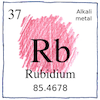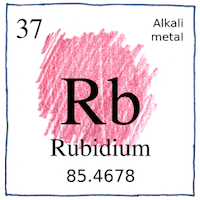Heidelberg—Robert Bunsen,
Gustav Kirchhoff
elements

|
Rubidium
Robert Bunsen and Gustav Kirchhoff by flame emission spectroscopy of the mineral lepidolite discovered a second new element having bright deep red lines and named it after the Latin rubidus.
Atomic number 37
Rubidium gives fireworks a purple color Vaporized rubidium-87 cools lasers. Rubidium-82 for positron emission tomography locates brain tumors. Rubidium occillators synchronize telecommunications.
Pyrophoric stuff
In air, pure rubidium splits water molecules and burns its hydrogen. A surprising number of materials combust spontaneously, including human beings, according to Charles Dickens, which makes one question whether our stability is really freakish.



Bunsen and Kirchhoff obtained rubidium chloride from the same mineral water, from Dürkheim, in which they had discovered caesium, so rubidium became the second element discovered with a spectroscope. Bunsen attempted to isolate the metal by electrolysis of molten rubidium chloride; however, was only partially successful. So he tried again by heating charred rubidium tartrate, and this was successful. Bunsen managed to measure its density and melting point even though rubidium explodes from the humidity in air.
See also in The book of science:
Readings in wikipedia:
Other readings: